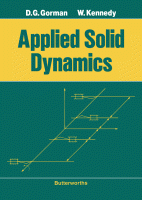Browse content
Table of contents
Actions for selected chapters
- Full text access
- Book chapterNo access
1 - Introduction
Pages 1-12 - Book chapterNo access
2 - Power transmission through gear systems
Pages 13-30 - Book chapterNo access
3 - Dynamics of a solid body in general plane motion
Pages 31-47 - Book chapterNo access
4 - Turning moment diagrams and flywheel design
Pages 48-61 - Book chapterNo access
5 - Applications of friction
Pages 62-82 - Book chapterNo access
6 - Out-of-balance and balancing of rotating mass systems
Pages 83-99 - Book chapterNo access
7 - Out-of-balance and balancing of reciprocating mass systems
Pages 100-117 - Book chapterNo access
8 - Introduction to dynamics of general space motion
Pages 118-136 - Book chapterNo access
9 - Vibration of a single degree of freedom system
Pages 137-166 - Book chapterNo access
10 - Free undamped vibration of a two degree of freedom system
Pages 167-182 - Book chapterNo access
11 - Vibration of multiple degree of freedom lumped mass systems—matrix analysis
Pages 183-198 - Book chapterNo access
12 - Free vibration of continuous systems
Pages 199-233 - Book chapterNo access
13 - Introduction to vibratory control
Pages 234-241 - Book chapterNo access
Appendix 1 - Standard integrals
Pages 242-244 - Book chapterNo access
Appendix 2 - Basic complex algebra
Pages 245-246 - Book chapterNo access
Appendix 3 - Basic vector algebra
Pages 247-248 - Book chapterNo access
Index
Pages 249-251
About the book
Description
Applied Solid Dynamics covers the dynamics of solids and, in particular, some of its applications to modern systems. The book aims to help students bridge the gap between theoretical knowledge and practical application. Chapter 1 formulates the concept of dynamically equivalent systems, the use of which enables even the most complex of systems to be represented by a much simpler model, provided certain important criteria are met. Chapter 2 demonstrates the usefulness of this concept by introducing an innovative vector system for the analysis of epicyclic gear transmission. Chapter 3 investigates the dynamics of a solid body in general plane motion, and Chapter 4 demonstrates the effect of intermittent energy transfer in a reciprocating system by using turning moment diagrams and the flywheel design. The applications of friction; the problems associated with rotational out-of-balance; and the dynamics of general space motion are tackled in the next four chapters. Chapters 9-12 discuss the analysis and prediction of the vibrating response of mass and elastic systems, whether such systems are single- or multi-degree of freedom in nature or are modeled in terms of lumped to distributed parameters. The book concludes by apprising active and passive vibratory control. Mechanical engineers will find this book invaluable.
Applied Solid Dynamics covers the dynamics of solids and, in particular, some of its applications to modern systems. The book aims to help students bridge the gap between theoretical knowledge and practical application. Chapter 1 formulates the concept of dynamically equivalent systems, the use of which enables even the most complex of systems to be represented by a much simpler model, provided certain important criteria are met. Chapter 2 demonstrates the usefulness of this concept by introducing an innovative vector system for the analysis of epicyclic gear transmission. Chapter 3 investigates the dynamics of a solid body in general plane motion, and Chapter 4 demonstrates the effect of intermittent energy transfer in a reciprocating system by using turning moment diagrams and the flywheel design. The applications of friction; the problems associated with rotational out-of-balance; and the dynamics of general space motion are tackled in the next four chapters. Chapters 9-12 discuss the analysis and prediction of the vibrating response of mass and elastic systems, whether such systems are single- or multi-degree of freedom in nature or are modeled in terms of lumped to distributed parameters. The book concludes by apprising active and passive vibratory control. Mechanical engineers will find this book invaluable.
Details
ISBN
978-0-408-02309-2
Language
English
Published
1988
Copyright
Copyright © 1988 Elsevier Ltd. All rights reserved.
Imprint
Butterworth-Heinemann
